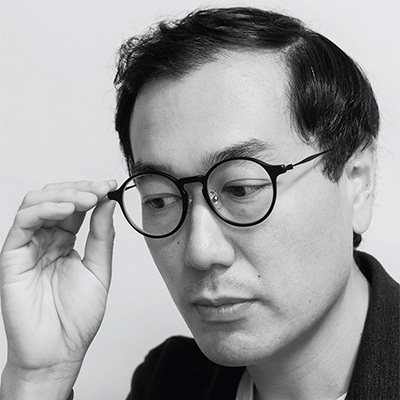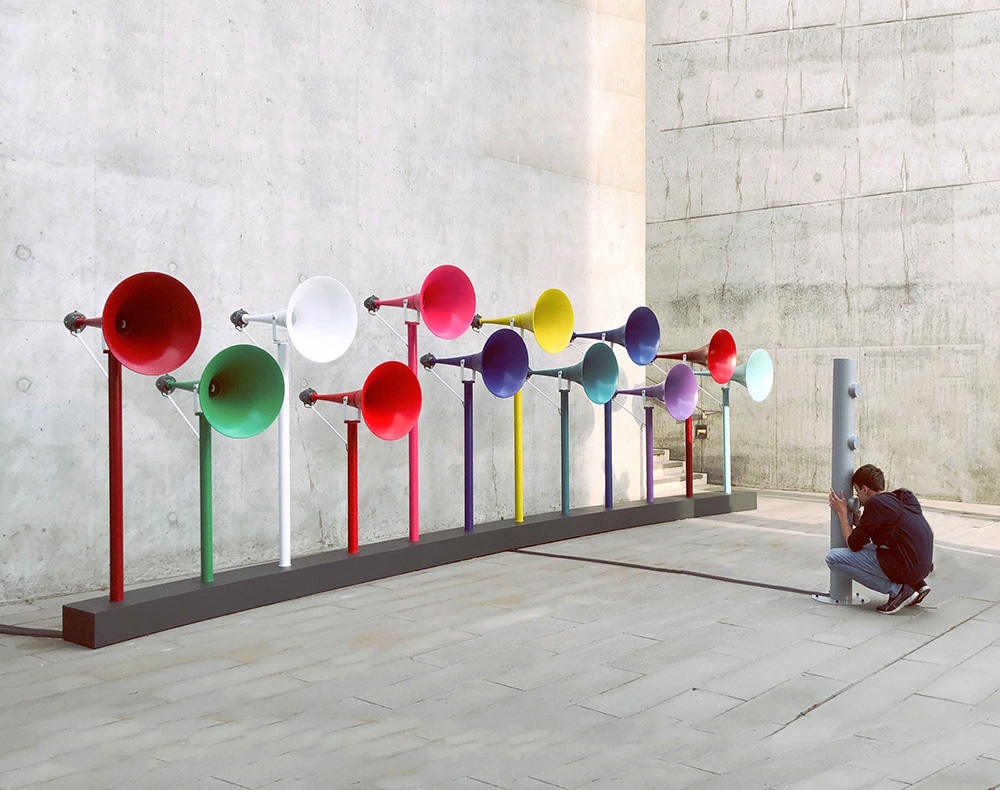Note: This website was automatically translated, so some terms or nuances may not be completely accurate.
Exploring the Potential of Sound Design with Yuri Suzuki
"CX Through Sound Design." This series introduces Dentsu Inc.'s various initiatives focused on the medium of "sound."
Part 1 explored the relationship between UI (user interface) and sound design, while Part 2 introduced Dentsu Lab Tokyo's "33 Production" initiative, which focuses on the diverse functions of the ear.
In Part 3, we explore the potential of sound design through a conversation between Yuri Suzuki—who works as an artist and also handles corporate brand design as a partner at the global design firm Pentagram—and Yasuhiro Tsuchiya of Dentsu Lab Tokyo.

Yuri Suzuki
Born in Tokyo in 1980. After graduating university, he moved to the UK and enrolled in the Royal College of Art (RCA) Design Products MA program in 2006. Following graduation, he worked as a designer for Swedish electronic instrument maker Teenage Engineering and Disney Research in Pittsburgh, USA, while continuing his artistic practice. In 2008, he established Yuri Suzuki Ltd in London. Since 2018, he has been a Partner (co-director) at Pentagram, the world's largest independent design consultancy. As a sound artist, his works are exhibited in museums worldwide. "OTOTO" (a DIY synthesizer) and "Colour Chaser" (a music toy themed on synesthesia) became part of the permanent collection at the Museum of Modern Art (MoMA) in New York in 2014.
<Table of Contents>
▼From an Interest in Sound/Music/Instruments to the Path of Art/Design
▼Strategy from the Library
▼Public Sound Design: Differences Between Japan and the UK
▼The Power of Sound Acting on the Subconscious
From an interest in sound/music/instruments to the path of art/design
Tsuchiya: Yuri, you work as an artist based in the UK while also serving as a partner at the global design firm Pentagram.
Suzuki: After earning a design degree from the Royal College of Art (RCA) graduate school, I began my artistic practice, exhibiting in galleries and museums. Later, I worked as a designer for companies like Swedish electronic instrument maker Teenage Engineering and Disney Research in the US. In 2018, I was invited by Pentagram to become a partner, a role I hold today. My mission at Pentagram is to establish and get the sound design division up and running.
Tsuchiya: Yuri, all your works seem to center on sound. What led you to focus on sound in your creative process?

Suzuki: My roots lie in my father's extensive record collection and my love for music since childhood. I especially loved electronic music. Seeing synthesizers in photos of YMO captivated me with their beautiful design. I started creating electronic music myself around high school. I think my interest and curiosity about sound were cultivated then. It felt like my interest in the three elements—"sound," "music," and "instruments"—arose simultaneously within me.
From that time until I went to the UK, I worked as an assistant for the artist unit "Mayu Denki." I was drawn to their stance as both contemporary artists and musicians. At the time, Meiwa Denki was referred to as media artists. It was also a period when the ICC (NTT InterCommunication Center) opened in Shinjuku, and I encountered Toshio Iwai's work there, becoming deeply interested in media art. At Meiwa Denki, I learned about many things, including media art.
Later, while studying product design at RCA, I became interested in interaction design. Through my studies, I came to see "communication without words" as the main topic of interaction design. I also thought this might be common to sound design, which became one reason I focused on sound in my work.
Tsuchiya: You've undertaken numerous projects across two distinct fields: artistic practice and client work. How do you balance these two areas?
Suzuki: Fundamentally, I don't separate them or try to balance them. People often say things like "client work is tough" or "art projects are free," but that's not the case at all. For example, when I worked on a Google project, I was given the freedom to pursue themes that expressed my own artistic sensibility. On the other hand, public art projects for galleries and such can be challenging with many constraints. So, for me, there's actually no boundary between my artist practice and client work. Even after becoming a partner at Pentagram, I feel my artistic work and client projects continue to mutually influence each other and function well.
Strategy over Library
Tsuchiya: You're currently advancing the field of sound design within Pentagram. Do you sense a growing demand for sound design?
Suzuki: When I joined Pentagram 18 years ago, clients never requested branding through sound—what we call "sonic branding." But over the past four years, it's gradually increased. It will likely keep growing. Since Pentagram originally handles a lot of graphic brand identities, it's a natural fit.
There are companies out there claiming to do "sonic branding," but many still offer only library-based solutions—essentially an extension of stock music library production, saying things like, "We've prepared about 100 sounds; please select 10 you like." Many clients fundamentally don't know where to turn for sonic branding. I feel this current state is one factor holding back the growth of the sound design field.
As demand for sonic branding grows, I believe the focus will shift from libraries to strategy. Without this shift, the field of sound design won't evolve. To achieve this, I think people with a background in design, rather than musicians, should be involved in sound design.
Tsuchiya: I see. So, while the "engineering" of sound—creating music or sounds—is often done well, the conceptual part, the "design"—the fundamental strategy for how sound should be created—is frequently lacking.
If we're going to treat it as "design," then I think we need to design the sound based on conditions like what role the sound is meant to play, in what kind of environment it will be heard, and how often it will be heard.
In everyday life, are there any products or services where you feel, "Wow, this has excellent sound design"?
Suzuki: Sound UX (user experience), right? Honestly, I don't see many products out there where I think, "Wow, they really put effort into designing this sound." However, I am increasingly being asked to give talks on sound UX design and receive proposals from clients about it. Interest in sound design within companies is definitely growing. I expect we'll start seeing more tangible outputs of this in the future.
Tsuchiya: When discussing sound design, the topic of EV (electric vehicle) sounds inevitably comes up. It's precisely the field where sound design is needed—addressing complex challenges like conveying speed and vehicle proximity for functional aspects, and capturing the sensory "driving feel" previously provided by engine sounds. As automobiles increasingly shift toward EVs, I wonder how many people are truly capable of handling sound design appropriately in this context.

Suzuki: Who to commission for EV sound design is a major issue. Many companies end up hiring famous musicians. While that's fine, I'd prefer they commission designers who can approach sound design based on strategy.
Regarding EV sound design, the first thing to consider is protocol. For example, regarding sound volume, rules are being established, like national guidelines specifying a minimum decibel level. However, aspects like what frequency band (pitch) the sound should be in remain undefined. If each company's EV emitted sounds in completely different frequency bands, it could potentially become noise pollution.
Tsuchiya: Indeed, how EV sounds are designed will significantly alter the urban soundscape when EVs become the majority in the future. Designing sound can be said to also mean designing the environment.
Public Sound Design: Differences Between Japan and the UK
Tsuchiya: Japan and the UK have historical and cultural differences in the size and structure of buildings found in their cities. This naturally leads to differences in sound design, I believe. From the perspective of sound design in public spaces, do you perceive any differences between Japan and the UK?
Suzuki: Hmm... I feel the UK isn't as thoughtful as Japan in this regard. For example, in Japan, JR departure melodies differ at each station. That shows consideration for public sound design. The UK doesn't have many such examples.
Rather than the UK, let me share an example from Switzerland. Swiss trains have "quiet carriages" designated for passengers who prefer a quiet environment. I thought it was well done, especially since they also installed panels inside the carriages where passengers can control the volume of the train announcements.
Tsuchiya: That's great. Personally, I prefer quiet carriages too.
Suzuki: Compared to that, the UK is behind. The announcements are often distorted and hard to hear, or the volume is too loud and just noisy.

Tsuchiya: Speaking of public transportation, the monorail stations I frequently use have audio devices installed to safely guide visually impaired passengers. They used to play a "ping-pong" sound like a doorbell, but recently they switched to realistic bird chirping sounds that are long enough you hardly notice any repetition.
Since monorail stations are often very close to residential areas, there were apparently complaints about the same sound repeating constantly. For visually impaired people, heading toward the direction of the bird sounds reliably leads them to the exit, while nearby residents are freed from the annoyance of the repeated bell. I thought it was an excellent idea that solved both problems at once.
Suzuki: Sounds that don't feel repetitive are really important, right? Repetition is what humans find most stressful.
Previously, I designed a call tone for a conference system at a client's request. Our approach was to design the sound using polyrhythms to ensure the loop was absolutely undetectable. This was because the human brain finds repetition extremely stressful, so we believed it was essential to program it in a way that didn't feel repetitive.
Tsuchiya: I see. While the final product is music, hearing your approach makes "design" feel like a much more fitting term than "composition."
The Power of Sound That Acts Unconsciously
Tsuchiya: Since switching to remote work and having more video conferences, I noticed something: when three or four people are discussing, voices inevitably overlap at times. In a physical space, you can distinguish them, but in a video conference, you can't, and I found it bothersome how the discussion would stop every time that happened.
So recently, I tried holding meetings several times using "Horizon Workrooms," a VR meeting system Meta is developing. Inside the virtual meeting room, the way you hear sounds changes depending on the direction you're facing, where the other person is located, and the direction they're facing. This means that even when several people speak at once, you can clearly distinguish their voices.
Suzuki: When humans hear sounds, it's said our brains select which sounds to focus on, rather than processing every single sound entering our ears. But with video conferences or pre-recorded audio, everything sounds flat, making it hard for the brain to focus. Reproducing sound localization in VR to enable this focus is a simple yet incredibly elegant solution.
Speaking of work environments, I often listen to music while working. The tempo of the music I'm listening to does slightly change my work pace and physical movements, doesn't it? That doesn't really happen with visuals. The idea that music tempo subconsciously affects performance is a fascinating phenomenon, a real possibility of sound.
Tsuchiya: The so-called BGM business—providing records for work environments like offices and factories—is said to have started in the 1930s. Among BGM providers, America's Muzak company apparently organized music based on its effects—like slow songs calming moods and upbeat tunes preventing drowsiness—and built daily playlists around a unique theory of sustaining worker concentration.

Suzuki: BGM isn't music you actively listen to, but it subconsciously affects performance. It's an interesting theme to explore in depth.
Tsuchiya: The relationship between sounds—BGM included—and their effects on humans has been studied extensively for years within fields like psychoacoustics and auditory psychology. Drawing insights from this research to inform experience design is crucial for expanding the scope of sound design going forward.
Suzuki: Fields like psychoacoustics are fascinating because they help prove and systematize the potential of sound that we've previously understood only empirically. Incorporating psychoacoustic principles could lead to better sound design, couldn't it?
Tsuchiya: The fact that non-verbal information can directly influence humans is truly remarkable. Similar to visual design, using sound as an entry point for design seems capable of enhancing various experiences—from products and services to solving diverse problems.
Today, I gained many valuable insights that will help me explore the possibilities of sound design. Thank you very much.
Was this article helpful?
Newsletter registration is here
We select and publish important news every day
For inquiries about this article
Back Numbers
Author

Yasuhiro Tsuchiya
Dentsu Inc.
zero/Dentsu Lab Tokyo
Creative Technologist / Researcher
After working at an advertising production company, joined Dentsu Inc. in 2006. Assigned to the CX Creative Center in 2021. Engaged in research and development of products centered on fields such as biosignals and robotics, aiming to develop and implement "slightly futuristic communication" utilizing technology.





